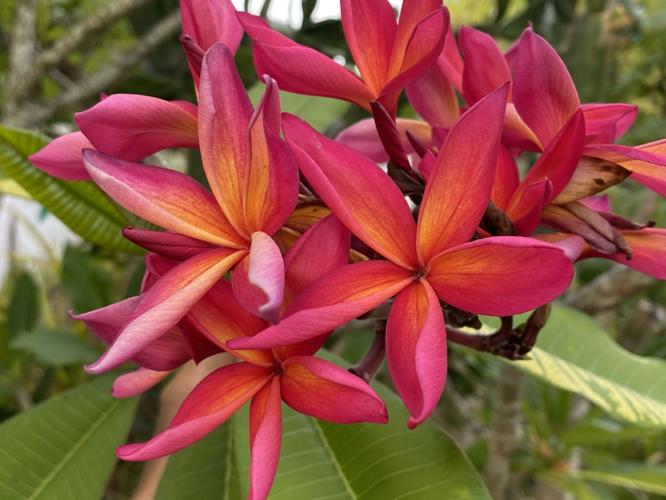Plumerias, also called frangipanis, are known for their drop-dead gorgeous beauty and exotic fragrance. You think of Hawaii or the tropics and wearing the multicolored fragrant lei flower. The Plumeria is a flowering plant that is also native to the warm climates of Mexico, the Caribbean and South and Central America.
Growing up I remember walking over grassy lawns picking up fallen plumeria blossoms and stringing them into a child’s necklace. Sometimes I would gather the blossoms and float them in a large bowl, which I still do while the scent would fill the room.
Some plumerias are very tall trees covered with masses of floral beauties while others are smaller. The leaves come in different shades of green. Some shed their leaves in the cooler weather, but others stay green year-round.
It is difficult to describe the smell of plumeria, and it will all depend on the variety you have in your landscape. Each plumeria blossom has its own unique scent. Some are very powerful and can dominate the garden on a warm and humid evening.
Some have a citrusy scent; others have a jasmine, coconut, spicy, rosy or a combination of several scents. Along with the varieties of scents, the flower color also varies from pure white to deep red and many combinations in between. Most of the flowers are fragrant at night.
The combination of some hard-to-find colors and scent adds to some plumeria varieties being more sought after than others. Plumeria collectors pay big money for that rare combination. I have a few plumeria plants in my backyard which all came from gardeners willing to share their cuttings.
Plumerias are very easy to grow from cuttings; simply cut an end from a non-blooming branch, defoliate the leaves, and let it dry for a few days and then plant it. Once planted – forget about it. In propagating plumerias from cuttings you are guaranteed that the new plant will be identical to the parent plant. Growing plumeria from seeds takes too long and you never know what you are going to get.
Plumerias have very few insect or disease problems and they prefer full sun but will tolerate modest shade. They are also very tolerant of many soil types; they are salt tolerant and drought tolerant.
My absolute favorite for its scent is the Plumeria (obtusa) Singapore White. It has simple snowy white flower clusters with a strong jasmine-citrussy scent. It is a small compact dwarf variety with glossy green evergreen obtuse shaped leaves with blooms all year.
I came upon a profuse flowering Singapore White during my daily runs, and I always stopped to smell the blossoms. One day, a demolition crew appeared, and I asked if I could take cuttings from the tree prior to their removal. They allowed me to take as many cuttings as I wanted, which I also shared some with friends.
A very popular and common specie is the Aztec Gold with an overall golden color with edges of white. It is very fragrant resembling the smell of ripe peaches and I received several cuttings from a friend. Aztec Gold is a heavy bloomer during the summer and excellent for large containers or patios.
The Penang Peach evokes warm and fragrant tropical breezes on a tropical island – such as Marco, in the early evening. It has a sweet lemon/mild peach fragrance. A reliable bloomer the flowers become more orange and intense during the hot summer.
The Darwin Blood Red with clusters of rich crimson color makes a stunning presence in the garden. It is a late bloomer with slight spicy scent. This is a hard-to-find variety was rescued after Hurricane Irma and shared with several friends.
If you had to choose which variety to take to a desert island with you? For the scent, I would take Singapore White and for the color, the Darwin Blood Red.
Caution: The milky sap of the plumeria is poisonous and may irritate the eyes and skin.








Post a comment as Guest
Report
Watch this discussion.
(0) comments
Welcome to the discussion.
Log In
Keep it Clean. Please avoid obscene, vulgar, lewd, racist or sexually-oriented language.
PLEASE TURN OFF YOUR CAPS LOCK.
Don't Threaten. Threats of harming another person will not be tolerated.
Be Truthful. Don't knowingly lie about anyone or anything.
Be Nice. No racism, sexism or any sort of -ism that is degrading to another person.
Be Proactive. Use the 'Report' link on each comment to let us know of abusive posts.
Share with Us. We'd love to hear eyewitness accounts, the history behind an article.